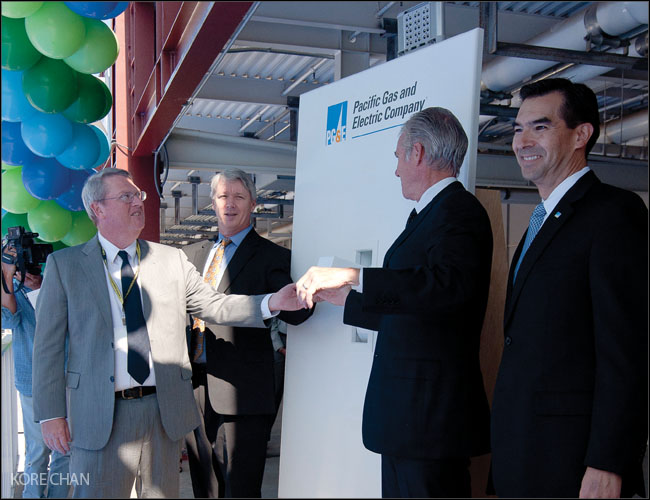
Monday September, 26, Aragon hosted the Clean Renewable Energy Dedication, a commemoration for the newly installed solar panels. Speakers from varying professions around the state were there to commemorate the event in front of Aragon’s faculty and the entire student body. State Superintendent Tom Torlakson was the keynote speaker and presented his “Schools of the Future” initiative which focuses on state school facility program reform and green schools.
Among the other speakers was Aragon alumnus Jason Bade, a student who was instrumental in the push for solar panels. Bade proposed the idea to have the solar panels installed. “It was the end of my sophomore year, and I always had this idea that solar panels were cool, so I started up the Environmental Impact Committee. Our two main goals were: recycling and solar.”
The EIC was formed with help of two teacher advisors, Doug McGlashan and Amy Schwartz. McGlashan spoke of Bade during his speech, saying, “A determined Jason Bade is a determined force and the only credit I give myself is not having gotten in his way and thus providing his sponsorship so that his student needs would be taken seriously.”
Though the event only lasted for a brief hour, the process of development and construction took about four years. “The solar panels were the fruits of many people’s labor,” said Bade.
Bade’s proposition would have to meet with district approval and would require coordinated efforts in order to be brought to fruition. He was directed to Deputy Superintendent of Business Services Elizabeth McManus, who had also installed solar at her previous school.
Budget cuts provided a difficult obstacle for the district to overcome, so McManus applied for various grants that could fund the initial investments. However, she said, “The construction contracts were coming in below budget, so all of a sudden I had some capacity. I was trying to look at different options of installing the panels.”
Peter Hanley, a member on the SMUHSD Board of Trustees, added, “We did a thorough analysis. The numbers started to look very positive and we had the benefit of the bond money under the current measure M.”
The solar panels were only recently completed even though Bade graduated a few years ago. Bade adds, “I think many people wanted the solar for a long time, and it was just figuring a way to make it work. It’s good that the community can see, now, the benefit and the positive impact that [the solar panels] are going to have on things other than just the environment, but also education, and the green economy.”
Supplied by SunPower, The solar panels were installed at Aragon, Burlingame, Hillsdale, and Mills. The seven acres of panels will save about $1.2 million a year and will generate about 64% of the District’s electrical needs, the equivalent of 3.72 megawatts. Increasing energy costs will enable the panels to save nearly $3 million in a decade.
Mark Quattrocchi came on behalf of Quattrocchi Kwok Architects, the company that designed the solar panel installation as well as several of the new buildings.
Though Aragon was not the first to install panels, Quattrocchi says, “3.72 megawatts is definitely one of the biggest [solar] projects. I hope there will be more growth in the industry. I think the cost and efficiency will definitely be improved.”
State Superintendent of Instruction Torlakson says, “From the saved money, [the green initiative] will create jobs, put money into the classroom, help save the environment, and create tens of thousands of teachable moments for the students.”
Torlakson’s Schools of the Future initiative focuses on creating an efficient learning environment. The team is comprised of many people from various professions including educators, business professionals, architects, school facility practitioners, green advocates, energy professionals, and policy makers.
Torlakson spoke of a state appointed energy liaison that will be in charge for finding other energy saving strategies for schools. Torlakson also said that future reforms to the school construction process will streamline schools to improve energy efficiency. A Green School Award will be awarded annually to schools who promote environmental efforts
Bill Savidge, Engineering Officer of West Contra Costa Unified School District, served as a chair of one of the sub groups in the Schools of the Future process. He said, “What we looked at was how can we as a state do a better job of building school facilities for the 21st century, how can we finance them, how can we make a commitment as a state, and engage in energy efficient projects.
Savidge expressed his ideas during his speech and said, “We have to have a commitment at the national level, state level, and local level to fund facilities and building schools because that’s how we remain competitive in the global market base.”
Torlakson hopes to implement new legislation, coining the idea “teamwork. ”I want to allow schools to build a solar farm to generate enough electricity to take care of a whole district.
However, he said, “According to the [current] energy quota, each school can only generate enough energy to support the school.”
Torlakson added, “I want it so that schools can put surplus energy into the grid and get paid for it. I want schools to make some money.”
Within the next few years, the new solar panels will easily compensate for the initial cost of the investment. Torlakson says, ‘This is a model day for other schools to follow.” Indeed, the new legislation and his Schools of the Future initiative plan to increase the benefits of environmentally-friendly technology, thereby encouraging other schools to follow suit.

